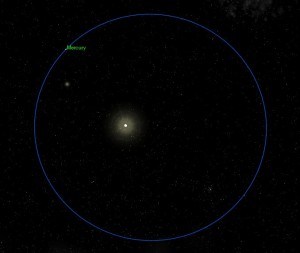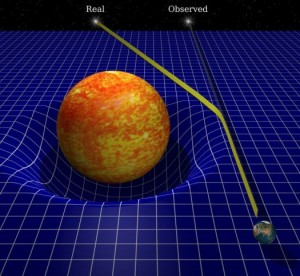16 Jan Einstein and Newton – Relativistic Twins
 On Nov. 25, 1915, Einstein announced that he had finally succeeded in explaining quantitatively “the secular rotation of the orbit of Mercury discovered by Le Verrier… without the need of any special hypothesis”. This was at least as great an accomplishment as Newton’s, and it almost gave Einstein a heart attack… Einstein’s theory provided a mathematical basis for the gravitational field and vindicated Newton’s intuitive rejection of action-at-a-distance… The gravitational field could now take its place alongside the electromagnetic field as a true property of space, with its own field equations.
On Nov. 25, 1915, Einstein announced that he had finally succeeded in explaining quantitatively “the secular rotation of the orbit of Mercury discovered by Le Verrier… without the need of any special hypothesis”. This was at least as great an accomplishment as Newton’s, and it almost gave Einstein a heart attack… Einstein’s theory provided a mathematical basis for the gravitational field and vindicated Newton’s intuitive rejection of action-at-a-distance… The gravitational field could now take its place alongside the electromagnetic field as a true property of space, with its own field equations.
Just as Newton had a last minute dispute with his nemesis Hooke, so Einstein had a last minute dispute with David Hilbert. In June of 1915, before Einstein made his final breakthrough, Hilbert invited him to give two lectures at Göttingen. On November 20, five days before Einstein presented his final theory, Hilbert submitted a paper that contained virtually the same equations, albeit without the vital calculation of Mercury’s orbit. Einstein then complained angrily to Hilbert that he had plagiarized the ideas that had been presented at Göttingen. It was only after Hilbert apologized, saying “this talk had completely slipped my mind,” that Einstein could write:
I have struggled with complete success against a feeling of bitterness… I think of you once again with untroubled friendliness and ask you to try to do the same regarding me. – A. Einstein (P1982, p. 260).
 The agreement with Mercury’s orbit was in itself convincing and sufficient to establish Einstein’s new theory, but Einstein didn’t stop there. His theory produced several predictions, the chief of which was that light rays passing close to a massive object would be deflected from their original path by the gravitational pull of the object. As Einstein pointed out, this prediction could be tested by observing shifts in the position of stars during a solar eclipse…
The agreement with Mercury’s orbit was in itself convincing and sufficient to establish Einstein’s new theory, but Einstein didn’t stop there. His theory produced several predictions, the chief of which was that light rays passing close to a massive object would be deflected from their original path by the gravitational pull of the object. As Einstein pointed out, this prediction could be tested by observing shifts in the position of stars during a solar eclipse…
Einstein was not the only one to make such a prediction. The other person was… Isaac Newton:
I shall conclude with proposing only some Queries, in order to a farther search to be made by others. Query 1. Do not bodies act upon light at a distance, and by their action bend its rays; and is not this action strongest at the least distance? – I. Newton (N1979, p. 339)
Newton’s speculation was based on his belief that light is corpuscular. The calculation, however, could not be made in Newton’s time because the speed of light wasn’t known. When it was eventually measured, the calculation was made and the result was a deflection of 0.9 angular seconds. Coincidentally, this was the same value that Einstein found in the early forms of his theory, but in the final formulation it had doubled to 1.8 angular seconds. This meant that astronomers now had the task of determining not only if there is a deflection, but which theory it agreed with.
Expeditions. Sir Arthur Eddington pointed out that a suitable eclipse was slated to occur on November 6, 1919, and so the Royal Astronomical Society of London dispatched teams of astronomers to Brazil and West Africa to make the necessary observations. Both expeditions ran into bad weather and technical problems… When the groups returned and analyzed the data, they found that there was indeed a deflection. Since no one had observed any deflection before, this was in itself a triumph. More importantly, they found that the magnitude agreed with Einstein’s prediction…
As it happens, in 1735 France had sent two teams to prove (or disprove) a result of Newton’s theory: the earth’s equatorial bulge. One expedition went to Peru and the other to Scandinavia. They encountered even more mishaps than the 1919 expeditions, but in the end, Newton’s theory was confirmed…
A successful prediction is worth ten retroactive explanations, and the drama of the expeditions only added to the excitement. The result was that Einstein was virtually canonized.
Einstein was now world famous. Ordinary people might not understand his theories and might only grasp dimly what it was all about but there was no question that they understood him to be the scientist. No scientist was so revered in his own time since Newton. – I. Asimov (A1982, p. 677)
When one looks at the paths that Newton and Einstein followed while pursuing their theories of gravity, one is struck by the many coincidences: the unexplained data on orbits, the sudden insight about falling objects, the need for a new mathematics, the calculational difficulties, the retroactive agreements, the controversy, the problem-plagued expeditions, and the final triumph and acclaim. Both men had worked in the same eccentric and lonely way, divorced from other scientists, armed with a great feeling of self-reliance while struggling with new concepts and difficult mathematics, and both produced earth-shaking results. One can’t help but wonder if these two greatest of scientists, born 237 years apart, were “relativistically related”, conceived as twins in some ethereal plane in a far-off galaxy and sent to earth to solve a matter of some gravity.
Posted By: Rodney Brooks

Sorry, the comment form is closed at this time.